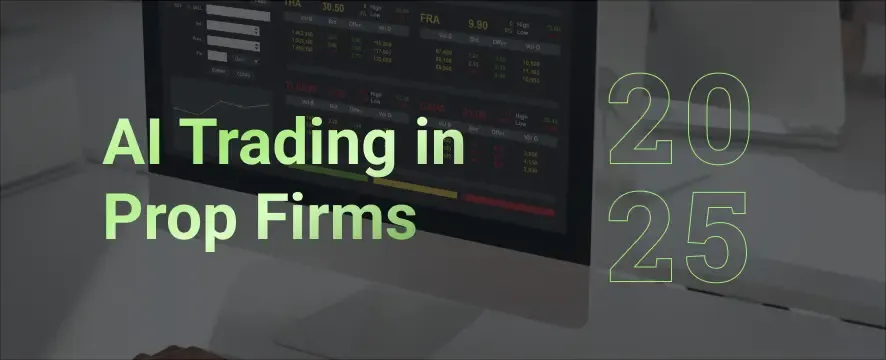
18 min read
Funded Trading Accounts Explained: Types, Benefits & How to Get One
A funded trading account gives you access to a firm’s capital to trade, share profits, and reduce personal risk.
16 min read
Share
Discover the essentials of proprietary trading and learn what a prop firm is. Understand the benefits and risks involved. Read the full guide now!

Prop firms provide traders with up to $400,000 in capital, revolutionizing how trading works in 2025.
A proprietary trading firm—commonly called a prop firm—is a company that allows qualified proprietary traders to trade financial markets using the firm’s capital.
Instead of trading with their own money, traders take part in a profit-sharing agreement with a prop firm based on the profits generated by the trader, typically receiving 70% to 90% of the profits they generate, while the firm keeps the rest. This model has opened the door for thousands of traders to participate in global markets with minimal upfront investment.
The prop trading industry has experienced explosive growth over the last few years, and funded trader programs have emerged as a primary driver of market expansion because they provide retail traders with a legitimate path to professional trading careers.
Seacrest Funded operates as a broker-backed prop firm that largely bases its performance on trader achievements. The company earns its income primarily through the trader's success, which sets it apart as one of the few firms that actually puts trader performance first.
In profit-sharing arrangements, both the firm and the trader benefit from the profits generated, creating a collaborative partnership focused on traders reaching their profit targets.
To understand how prop firms operate, you need to look under the hood of their business model. These firms are not simply handing out free money. Instead, they operate a structured and performance-based funding model designed to protect their own funds while rewarding traders who prove their skills.
The success of many prop firms depends largely on the profitability of their traders. Prop firms generate revenue from trader profits, but they recover expenses through evaluation fees that cover platform costs and administrative expenses.
The evaluation process completed by traders leads to receiving a funded trading account that allows them to execute trades using the firm's capital—either simulated or real—while following precise risk guidelines.
The firm provides everything else: a trading platform, account access, performance tracking, and even scaling plans. In return, the best prop trading firms share in a percentage of the trader’s profits.
Imagine accessing up to $400,000 in simulated trading capital after demonstrating your trading ability through a rigorous evaluation process. However, evaluation fees and performance risks still apply.
Prop firms give traders access to more capital than they could typically obtain on their own, enabling larger position sizes and potentially higher profits.
The profit distribution typically follows a ratio of 70/30 to 90/10, with traders receiving the higher share of the profit generated by their trading activities.
Some firms implement performance-based reward systems that grant traders increased capital access and better profit sharing when they demonstrate consistent trading performance and effective risk management.
The financial rewards of these systems, including the potential for substantial profits, drive traders to maintain a professional approach to their trading activities instead of treating them as casual work.
The firm protects its capital through strict requirements and trading regulations that traders need to follow. The trading rules enforce maximum daily drawdown limits (usually around 4-5%) and total maximum loss of about 10%.
When traders break these rules, their evaluation process fails, and traders may lose their funded trading account. These strict requirements and rules are designed to manage the risks inherent in proprietary trading, such as financial losses and exposure to market fluctuations.
The majority of prop firms utilize popular trading platforms alongside customized dashboards. Top prop firms invest in cutting-edge technology to provide traders with advanced tools and features. Access to technological resources, such as robust trading platforms and real-time data, is crucial for trading success.
These platforms are selected for their ability to provide fast order execution, comprehensive charting tools, algorithmic trading support, and secure trade logging. A trader’s achievement depends heavily on their platform system since delayed trades during market volatility can either succeed or fail, and firms must continually upgrade their technology to remain competitive.
A prop firm requires traders to pass one or multiple evaluation phases prior to funding their accounts. During the evaluation, firms often look for a track record of trading performance to assess the trader's reliability and consistency.
The testing stages assess a trader’s capability to achieve profit targets through simulated real-time conditions while following the firm’s specified trading rules. Traders typically need to achieve between an 8-10% profit target during their initial 30-day Phase 1 before proceeding to the Verification Phase (Phase 2), which usually requires them to earn 4-5% profit under tightened risk parameters.
Firms examine both profit performance and discipline levels, trade strategy implementation, and trader consistency.
Successful proprietary traders get access to scaling plans that enable their account balance to grow step by step. Some firms use capital increases of 25% every three months based on performance milestones. Yet, other firms base their scaling on traders’ ability to maintain consistent results while controlling drawdowns.
Scaling opportunities are often reserved for traders who demonstrate consistent profitability over time. To achieve the performance benchmarks required for scaling, traders may use different trading strategies, selecting approaches that best fit their operational style and risk tolerance.
Scaling allows traders to grow their simulated account size as they meet performance goals—often unlocking higher potential profit splits and advanced features.
Not all prop firms operate the same way. Over the last few years, a variety of programs have emerged to accommodate different trading styles and levels of experience. Many prop firms may offer programs for trading other financial instruments beyond just forex, allowing traders to access other instruments such as stocks, commodities, and crypto-assets.
This is the most common format. Traditional challenge models often involve upfront costs, typically in the form of evaluation fees that must be paid to participate.
The completion of profit targets in both Phase 1 and Phase 2 leads to funded account access. Traders with limited funds should choose these models because they need to follow the rules precisely while being patient and disciplined to achieve success.
Traders who choose instant funding do not need to participate in challenges because they pay extra to get direct access to a trading account. The main drawback of these accounts includes limited starting capital, together with enhanced trading restrictions. Experienced traders who desire immediate trading access might find the price worth the convenience of instant funding.
In copy trading setups, successful traders can allow others to mirror their trades, earning passive income in the process. Sometimes, the firm pools client capital into a master account managed by one or more lead traders. This model is great for those who have a consistent strategy and want to monetise their results without relying solely on profit splits.
Some firms combine aspects of traditional and instant funding models. A common hybrid structure might allow traders to skip Phase 1 but still require them to complete a short verification phase. These setups balance speed with risk assessment and are useful for traders who want a head start without skipping evaluation entirely.
If you're a beginner working with a limited budget, a traditional challenge may be the best way to get started. If you're already experienced and want to get going fast, instant funding offers convenience at a cost. For social traders or influencers, copy trading allows you to earn based on your followers’ activity.
A firm needs traders to pass their evaluation process before they can receive funded status. The evaluation process functions as a crucial assessment mechanism which tests your trading abilities together with your risk handling and your ability to maintain consistency.
These strict requirements are designed to ensure that only skilled traders, who demonstrate the necessary expertise and discipline, are ultimately funded. The following analysis explains each evaluation component to provide a complete understanding.
The evaluation process of prop firms typically consists of two distinct phases. The first phase demands traders to achieve between a profit target of around 8% to 10% (usually—but not always within a specified timeframe).
After completing Phase 1, traders advance to Phase 2, which is known as the verification phase. The profit objective in Phase 2 is normally lower—at around 4% to 5%, but risk limitations stay the same or become more stringent.
The evaluation phase establishes whether trading skills demonstrate persistence beyond temporary success. Firms monitor their trading profits along with their trading practices and risk management throughout both evaluation phases.
All prop firms establish rigid rules that serve to protect their capital investment. Prop firms commonly implement four sets of rules: overnight trade restrictions, lot size maximums, news event trading prohibitions, and mandatory stop-loss implementations.
These regulations eliminate impulsive trading behavior while rewarding users who implement dependable trading methods. Breaking these rules will result in evaluation failure or account loss for your funded position.
The outcome of the evaluation test strongly depends on maintaining proper risk management. The firms establish trading requirements that mandate daily losses don't exceed around 4% (more or less) and overall drawdowns not more than about 10%.
The success of prop trading requires traders to use consistent position sizing while avoiding any form of reckless leverage. Most traders experience failure by pursuing larger profits while disregarding established profit limits.
The success of trading depends on having a dependable internet connection and a good understanding of the platform. The use of API algorithms for automated trading strategies is permitted by some firms but forbidden by others during evaluation phases. Successful trading requires a full understanding of your platform before beginning to avoid costly mistakes.
Passing the evaluation is just the beginning. Prop trading firms provide individual traders with opportunities, such as access to specialized tools, funding, and structured environments, that they would not have on their own. Talented traders who consistently perform well are often promoted or given additional opportunities within the firm.
Funded traders maintain strict guidelines and structured systems, yet they obtain specialized tools and funding, and long-term career prospects, which typical retail traders cannot access on their own.
Every funded trader needs structure. Trading routines such as journaling past trades help many traders stay responsible and prevent themselves from repeating past errors. This requires traders to execute trades based on a proven strategy that follows all risk rules established by the prop firm.
After market hours, funded traders may spend time analyzing charts before reviewing their performance metrics to develop strategies for the upcoming trading session. Daily success requires discipline, together with consistent performance and mental clarity.
Profit splits are a key part of simulated funded trading programs. After passing evaluations, traders earn a share of profits based on their performance within the firm’s rules and systems. Most firms begin with a 70/30 profit split structure where traders receive 70% of profits, but the firm gets 30%. High-performing traders can expect to move towards an 80/20 profit split or perhaps even 90/10.
Some prop firms provide milestone-based bonus opportunities, which include higher profit splits when traders reach specific profit milestones such as $5,000 or $10,000.
Smooth payouts are a major sign of a reliable prop firm. Most top-tier firms process withdrawals on a bi-weekly or monthly schedule. Methods range from bank transfers to crypto payments, and firms often allow traders to withdraw profits as soon as they’re realized—without needing to hit a minimum.
Avoid firms that delay withdrawals or require complex compliance checks on every request. Fast, transparent payouts are a sign that the firm is prioritizing trader success and not just making money off evaluation fees.
Another great aspect of funded trading is having a pathway to scale your account up. A lot of prop firms offer growth programs that empower traders to continually trade larger and larger amounts.
Larger account balances not only offer more profit potential, but also improves the trader's credibility in the eyes of the prop firm, and opens the door to a genuine career path in trading.
Not all prop firms are built the same. A prop firm is a type of financial institution that uses its own capital to trade in financial markets for profit. Unlike brokerage firms, which handle client funds and charge fees for executing trades on behalf of clients, prop firms trade with their own money and do not manage client accounts.
Some are focused on short-term profits from evaluation fees, while others are genuinely interested in long-term trader development within financial institutions. Choosing the right firm can make or break your journey.
Before partnering with a prop firm, you need to assess the firm's operational framework, together with its payment conditions and disclosure standards. Examine their profit split percentages as well as their withdrawal requirements.
Also, read the fine print. The terms of service include any additional fees, such as platform costs and reset fees. Does the firm impose penalties for maintaining positions overnight along with trading during news-related events? These small details really matter.
The regulatory framework of prop firms operates independently from the traditional brokerage industry. However, that doesn't mean you shouldn't do due diligence. Check for valid indicators of business legitimacy through well-defined legal frameworks, a good trading platform, and regulatory broker partnerships—together with straightforward user agreements.
The absence of clear responses about funding models and regulatory compliance from a firm indicates a serious warning sign. A trustworthy firm maintains complete transparency regarding its business conduct.
Your professional abilities and not your financial resources are the main assets you trade when entering this field. But costs still matter. Evaluate all expenses related to the program, including evaluation fees and reset costs, as well as payout percentages and potential for growth.
A $500 evaluation with a 90% profit split and fast scaling may be a better investment than a $100 challenge with hidden restrictions and a 50% split. Focus on long-term potential instead of following low initial expenses.
A pre-decision assessment should be performed to determine readiness for joining any funded program. Prop trading seems attractive, but it does not match the requirements of all traders. Professional roles require both preparation and structured methods, along with the ability to control one's mindset.
Your assessment should focus on your trading abilities rather than how you feel about yourself. Do you have a tested, repeatable trading strategy? Have you collected at least three months of simulated or demo trading results?
It is fine to be unsure about things at this point. Attempting a $100K challenge without evidence of your trading skills is similar to operating a race car without proper licensure. The outcome might be positive by chance, but it would most probably lead to negative results.
Most challenges require between $50 to $500, while instant funding accounts reach beyond $1,000 in value. As always, avoid investing more than you can afford to lose.
Create a risk management strategy before beginning. You need to define your trading limits by establishing the maximum loss for each trade and daily and weekly loss restrictions.
Develop a system to prevent both excessive trading and impulsive trading. Set the number of daily trading setups you will take, as well as the times when you should step away from trading. The traders who achieve success at prop firms demonstrate both skill and persistent boring behavior.
This part is often overlooked. The process of prop trading combines technical skills with self-discipline and patience, together with emotional stability. Do you maintain your trading rules even when your trading performance produces consecutive losses? Can you prevent yourself from pursuing the market after missing a trading opportunity?
Before attempting a challenge, you should either study trading psychology or work with a coach if your answer is negative. Self-awareness is a huge edge.
Seacrest Funded provides a trader-friendly approach for new users to begin their prop trading journey. Their broker-backed model, transparent rules, and performance-based scaling make them stand out in a crowded market.
Since Seacrest Funded was launched, thousands of traders have become part of the platform, demonstrating that it is a viable path to growing a trading career over time. Skill and patience, together with discipline, represent what you need to succeed.
The prop trading industry is evolving fast. What began as a niche corner of finance has now become a legitimate career path for traders worldwide. In the coming years, prop trading firms will continue to engage in trading a wide range of assets, including stocks, futures, commodities, and other financial instruments.
Expect to see more AI-powered trading dashboards, smarter performance analytics, automated journaling tools, and real-time coaching integrations. Prop firms are also leaning into automation to identify top traders faster and support them more efficiently. The firms that adapt technologically will lead the pack.
In 2025, being a funded trader is about much more than just making some quick profits. Many prop traders grow to become coaches and brand ambassadors. With consistency and diligence, prop trading firms can become a legit career—not just a side gig.
You don’t need to quit your job or risk your life savings. You can start small without investing huge amounts, but like any trading path, there’s still financial and psychological risk involved.
Join a trader community and open a demo account—then watch how other funded traders operate. When you’re ready, take the challenge.
Risk Disclaimer: Trading carries risk. Evaluation fees are non-refundable. Performance in simulated environments does not guarantee real-world results. Seacrest Funded provides access to capital based on merit, not gambling. Approach the challenge like a job, and you'll have a real shot at long-term success.

18 min read
A funded trading account gives you access to a firm’s capital to trade, share profits, and reduce personal risk.

12 min read
Yes, some prop firms allow news trading. This 2025 guide shows which firms permit it, their rules, and how traders can benefit.

10 min read
A funded trader uses a prop firm’s capital instead of their own. Learn how funded accounts work, profit splits, and how to qualify.

13 min read
To become a funded trader in 2025, you must pass prop firm challenges by mastering strategy, risk control, and trading rules.

9 min read
Discover effective AI trading strategies for prop firms to enhance your profits. Learn practical tips to navigate the market successfully. Read more!
Get an insight from other users about SeacrestFunded and their experiences. 131K+ members and counting

Get instant access to weekly newsletter.